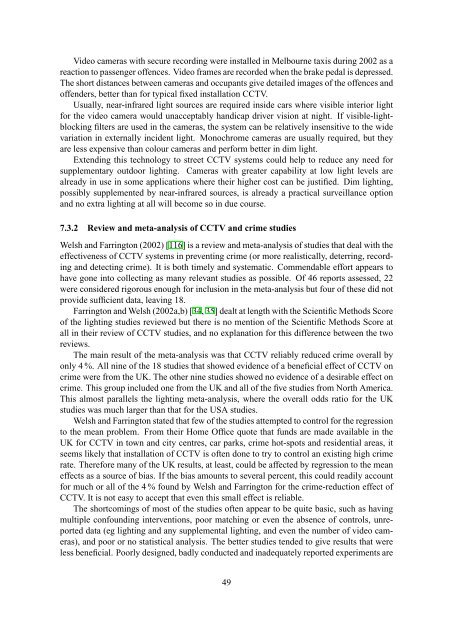outdoor lighting and crime, part 1 - Astronomical Society of Victoria
outdoor lighting and crime, part 1 - Astronomical Society of Victoria
outdoor lighting and crime, part 1 - Astronomical Society of Victoria
Create successful ePaper yourself
Turn your PDF publications into a flip-book with our unique Google optimized e-Paper software.
Video cameras with secure recording were installed in Melbourne taxis during 2002 as a<br />
reaction to passenger <strong>of</strong>fences. Video frames are recorded when the brake pedal is depressed.<br />
The short distances between cameras <strong>and</strong> occupants give detailed images <strong>of</strong> the <strong>of</strong>fences <strong>and</strong><br />
<strong>of</strong>fenders, better than for typical fixed installation CCTV.<br />
Usually, near-infrared light sources are required inside cars where visible interior light<br />
for the video camera would unacceptably h<strong>and</strong>icap driver vision at night. If visible-lightblocking<br />
filters are used in the cameras, the system can be relatively insensitive to the wide<br />
variation in externally incident light. Monochrome cameras are usually required, but they<br />
are less expensive than colour cameras <strong>and</strong> perform better in dim light.<br />
Extending this technology to street CCTV systems could help to reduce any need for<br />
supplementary <strong>outdoor</strong> <strong>lighting</strong>. Cameras with greater capability at low light levels are<br />
already in use in some applications where their higher cost can be justified. Dim <strong>lighting</strong>,<br />
possibly supplemented by near-infrared sources, is already a practical surveillance option<br />
<strong>and</strong> no extra <strong>lighting</strong> at all will become so in due course.<br />
7.3.2 Review <strong>and</strong> meta-analysis <strong>of</strong> CCTV <strong>and</strong> <strong>crime</strong> studies<br />
Welsh <strong>and</strong> Farrington (2002) [116] is a review <strong>and</strong> meta-analysis <strong>of</strong> studies that deal with the<br />
effectiveness <strong>of</strong> CCTV systems in preventing <strong>crime</strong> (or more realistically, deterring, recording<br />
<strong>and</strong> detecting <strong>crime</strong>). It is both timely <strong>and</strong> systematic. Commendable effort appears to<br />
have gone into collecting as many relevant studies as possible. Of 46 reports assessed, 22<br />
were considered rigorous enough for inclusion in the meta-analysis but four <strong>of</strong> these did not<br />
provide sufficient data, leaving 18.<br />
Farrington <strong>and</strong> Welsh (2002a,b) [34, 35] dealt at length with the Scientific Methods Score<br />
<strong>of</strong> the <strong>lighting</strong> studies reviewed but there is no mention <strong>of</strong> the Scientific Methods Score at<br />
all in their review <strong>of</strong> CCTV studies, <strong>and</strong> no explanation for this difference between the two<br />
reviews.<br />
The main result <strong>of</strong> the meta-analysis was that CCTV reliably reduced <strong>crime</strong> overall by<br />
only 4 %. All nine <strong>of</strong> the 18 studies that showed evidence <strong>of</strong> a beneficial effect <strong>of</strong> CCTV on<br />
<strong>crime</strong> were from the UK. The other nine studies showed no evidence <strong>of</strong> a desirable effect on<br />
<strong>crime</strong>. This group included one from the UK <strong>and</strong> all <strong>of</strong> the five studies from North America.<br />
This almost parallels the <strong>lighting</strong> meta-analysis, where the overall odds ratio for the UK<br />
studies was much larger than that for the USA studies.<br />
Welsh <strong>and</strong> Farrington stated that few <strong>of</strong> the studies attempted to control for the regression<br />
to the mean problem. From their Home Office quote that funds are made available in the<br />
UK for CCTV in town <strong>and</strong> city centres, car parks, <strong>crime</strong> hot-spots <strong>and</strong> residential areas, it<br />
seems likely that installation <strong>of</strong> CCTV is <strong>of</strong>ten done to try to control an existing high <strong>crime</strong><br />
rate. Therefore many <strong>of</strong> the UK results, at least, could be affected by regression to the mean<br />
effects as a source <strong>of</strong> bias. If the bias amounts to several percent, this could readily account<br />
for much or all <strong>of</strong> the 4 % found by Welsh <strong>and</strong> Farrington for the <strong>crime</strong>-reduction effect <strong>of</strong><br />
CCTV. It is not easy to accept that even this small effect is reliable.<br />
The shortcomings <strong>of</strong> most <strong>of</strong> the studies <strong>of</strong>ten appear to be quite basic, such as having<br />
multiple confounding interventions, poor matching or even the absence <strong>of</strong> controls, unreported<br />
data (eg <strong>lighting</strong> <strong>and</strong> any supplemental <strong>lighting</strong>, <strong>and</strong> even the number <strong>of</strong> video cameras),<br />
<strong>and</strong> poor or no statistical analysis. The better studies tended to give results that were<br />
less beneficial. Poorly designed, badly conducted <strong>and</strong> inadequately reported experiments are<br />
49
















